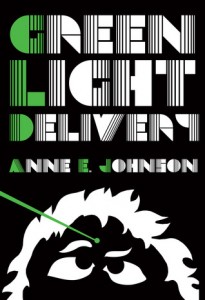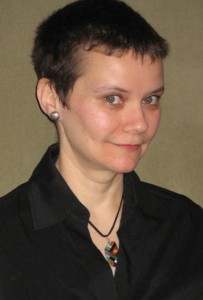by Anne E. Johnson
I’ve been a fan of science fiction since I was in high school, but Green Light Delivery was my first attempt to write a novel-length work in this genre. Of course, any type of fiction is a challenge to do well. But I found that writing science fiction offers special hurdles I had not run into before.
 Part of the over-arching challenge of science fiction is what a broad genre it is. When The Hitchhiker’s Guide to the Galaxy and The Gods Themselves are both placed under the same heading, you know you’re dealing with something bigger than any one definition can cover.
Part of the over-arching challenge of science fiction is what a broad genre it is. When The Hitchhiker’s Guide to the Galaxy and The Gods Themselves are both placed under the same heading, you know you’re dealing with something bigger than any one definition can cover.
Green Light Delivery is humorous. It is also set in an alternative universe, meaning that there are no humans, and never have been. These decisions about its setting brought up even more specific issues I hadn’t considered before I began. And I find, now that I’m well into drafting the sequel, that these were not simply beginner’s stumbles. I’m facing all these hurdles again. Good thing it’s so much fun!
The differently-abled alien. When you create an alternative universe, you need to people it with somebody. Even if you decide there are nothing but robots on your planet, you still need to know what they look like and what they can do. I chose to make the Raralt Planetary Circle (a set of four planets) be the home for many different species. Nice, I thought. So very Star Wars, I thought. But once I got rolling, I realized that inventing a creature and using it in fiction are two very different things. As I wrote scenes, I found that I couldn’t remember what all the different characters were shaped like. I wanted one to shake hands—or does he have flippers? Or neither? I wanted one to sit down—but how tall is she, and does she bend down into the chair or climb up into it? I wanted one to talk—how many mouths does it have, and where on its body are they situated?
It wasn’t such a big deal to keep track of the main characters’ physical attributes, but the secondary folks drove me crazy. The only answer was to keep a list.
What was his name, again? A list was also essential for naming. Most experienced authors have mixed up their characters’ names at some point. They call Amy by her best friend Sue’s name for three pages in the middle of Chapter Six, and their beta reader spots it. No biggie. With an alternative universe, I wanted the names to sound other-worldly. I love making up names by gluing phonemes together. I can do that all day. But five paragraphs later, I can’t remember the new guy’s name. I mean, not a clue. And forget about asking beta readers to keep track of this stuff. These people have jobs.
Moniker confusion was a problem not only for characters, but also for places, brands, holidays, and any other element of society that might be labeled with a proper noun. I made a very big, complex list. And now that I’m writing the sequel, I keep having to refer to the Green Light Delivery list so the details are consistent.
Just how humanoid? If there are no humans, how can the reader relate to the characters?
Of course, the characters must be driven by human desires and needs, or you won’t have a story. Even if the species are extremely different from humans in both their physiognomy and psychology, they must know happiness, sadness, fear, jealously, wrath, love, lust…and I would add humor, too. It doesn’t matter if the specifics are unfamiliar to the reader, as long as the motivation makes sense.
A closely related issue is that of human-language (in my case, English) and human-concept terms for various measurements. Do you have days and weeks, or make up some other delineation of time? Do you have hours and minutes? Miles and feet? Pounds and tons? In Green Light Delivery I found myself avoiding mention of specific measurements whenever possible rather than embellish the invented culture to that degree. Asimov and Roddenberry might not approve, but I needed to complete the manuscript.
 Drawing on an eclectic background that includes degrees in classical languages and musicology, Anne E. Johnson has published in a wide variety of topics and genres. She’s written feature articles about music in serials such as The New York Times and Stagebill Magazine, and seven non-fiction books for kids with the Rosen Group. Nearly thirty of her short stories, in various genres and for both children and adults, can be found in Underneath the Juniper Tree, Spaceports & Spidersilk , Shelter of Daylight, and elsewhere. The humorous, noir-inspired Green Light Delivery (Candlemark & Gleam) is her first science fiction novel. She is also a children’s author. Ebenezer’s Locker, a tween paranormal mystery novel, was recently published by MuseItUp. Her tween medieval mystery, Trouble at the Scriptorium will be released by Royal Fireworks Press in August. Anne lives in Brooklyn with her husband, playwright Ken Munch. Her website is http://AnneEJohnson.com.
Drawing on an eclectic background that includes degrees in classical languages and musicology, Anne E. Johnson has published in a wide variety of topics and genres. She’s written feature articles about music in serials such as The New York Times and Stagebill Magazine, and seven non-fiction books for kids with the Rosen Group. Nearly thirty of her short stories, in various genres and for both children and adults, can be found in Underneath the Juniper Tree, Spaceports & Spidersilk , Shelter of Daylight, and elsewhere. The humorous, noir-inspired Green Light Delivery (Candlemark & Gleam) is her first science fiction novel. She is also a children’s author. Ebenezer’s Locker, a tween paranormal mystery novel, was recently published by MuseItUp. Her tween medieval mystery, Trouble at the Scriptorium will be released by Royal Fireworks Press in August. Anne lives in Brooklyn with her husband, playwright Ken Munch. Her website is http://AnneEJohnson.com.

